Physical Education class: High School
| Volleyball | European Handball | Tennis | Cricket |
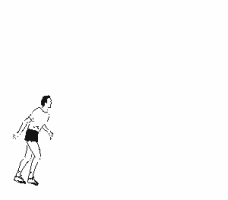
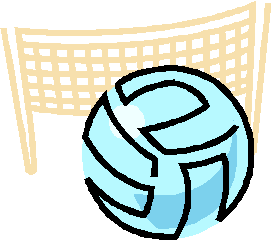
|
|
 |
THE SERVE
( A ) Server must serve from behind the restraining line ( end line
) until
after contact.
( B ) Ball may be served underhand or overhand.
( C ) Ball must be clearly visible to opponents before serve.
( D ) Served ball may graze the net and drop to the other side for
point.
( E ) First game serve is determined by a volley, each subsequent
game shall
be served by the previous game loser.
( F ) Serve must be returned by a bump only. no setting or attacking
a
serve.
SCORING
- Rally scoring will be used.
- There will be a point scored on every
score of the ball.
- Offense will score on a defense miss
or out of bounds hit.
- Defense will score on an offensive
miss, out of bounds hit, or serve into the net.
- Game will be played to 25 pts.
- Must win by 2 points.
ROTATION
( A ) Team will rotate each time they win the serve.
( B ) Players shall rotate in a clockwise manner.
( C ) There shall be 4-6 players on each side.
PLAYING THE GAME ( VOLLEY )
( A ) Maximum of three hits per side.
( B ) Player may not hit the ball twice in succession ( A block is
not
considered a hit ).
( C ) Ball may be played off the net during a volley and on serve.
( D ) A ball touching a boundary line is good.
( E ) A legal hit is contact with the ball by a player body above
and
including the waist which does not allow the ball to visibly come to a
rest.
( F ) If two or more players contact the ball simultaneously, it is
considered one play and the players involved may not participate in the
next
play.
( G ) A player must not block or attack a serve.
( H ) Switching positions will be allowed only between front line
players. (
After the serve only ).
BASIC VIOLATIONS
( A ) Stepping on or over the line on a serve.
( B ) Failure to serve the ball over the net successfully.
( C ) Hitting the ball illegally ( Carrying, Palming, Throwing, etc.
).
( D ) Touches of the net with any part of the body while the ball is
in
play. If the ball is driven into the net with such force that it causes
the net
to contact an opposing player, no foul will be called, and the ball
shall
continue to be in play.
( E ) Reaching over the net, except under these conditions:
1 - When executing a follow-through.
2 - When blocking a ball which is in the opponents court but is
being
returned ( the blocker must not contact the ball until after the
opponent who
is attempting to return the ball makes contact). Except to block the
third
play.
( F ) Reaches under the net ( if it interferes with the ball or
opposing
player ).
( G ) Failure to serve in the correct order.
( H ) Blocks or spikes from a position which is clearly not behind
the
10-foot line while in a back row position.
THE COURT
PLAYING AREA
Both indoor and outdoor courts are 18 m x 9mi (29'6" x 59').
Indoor courts also include an attack area designated by
a line 3 m (9'10") back from the center line.
Lines on the court are 5cm (2" wide).
NET HEIGHT
Net height for men, co-ed mixed 6, & outdoor is 2.43 meters or
7'11-5/8".
Net height for women, 7'4-1/8".
The height of the net shall be 8'.
BALL
The ball weighs between 9 and 10 ounces. Ball pressure is between 4.5
and 6.0
pounds
|
Volleyball Lingo |
Translation |
|
"Ace" |
When the
ball is served to the other team, and no one touches it. |
|
"Sideout" |
When the
team that served the ball makes a mistake, causing the ball to go to
the other team. |
|
"Roof" |
When a
player jumps above the height of the net, and blocks the ball. |
|
"Stuff" |
When a
player jumps about the height of the net, blocks the ball, and the ball
goes back at the person who attacked(spiked) the ball. |
|
"Dig" |
When a
player makes a save from a very difficult spike. |
|
"Kill" |
When a
team spikes the ball and it either ends in a point or a sideout. |
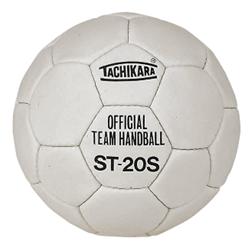

History of Team Handball
Team
handball is very popular in much of the world, but little known in
North America. Its very name is confusing even to an American who knows
quite a bit about sports.
The modern
game actually grew out of three sports that were developed,
independently, in three different European countries: The Czech hazena,
the Danish handbold, and the German Torball.
All three were
based on soccer, but essentially replaced the foot with the hand, so
that the ball could be advanced by batting or throwing, rather than by
kicking.
Hazena
was being played by Slovak peoples as early as 1892; its rules were
first codified in 1906, by a college professor. Handbold (the
Danish word for handball) was developed in 1898 by a teacher, Holger
Nielsen, as an alternative to soccer. In 1906, Nielsen revised the
rules considerably and began organizing competitions outside the school
at which he taught. Similarly, Torball was created in 1915 by a
German gymnastics teacher, Max Heiden.
Professor Carl
Schelenz of the Berlin Physical Education School in 1919 combined
elements of handbold and Torball and adapted the soccer
playing field for a new sport, which he called handball (actually
translating the Danish into German). Schelenz also borrowed from
basketball, which was just becoming popular in Germany, to allow
dribbling as a means of advancing the ball.
By 1925, the
game had become fairly popular in other European countries. The
International Amateur Handball Federation (IAHF) was established in
1928; handball was a demonstration sport at the Olympics that year and
again in 1932.
That form of
handball, designed to be played outdoors by teams of eleven players,
was a full-fledged Olympic sport at the 1936 Munich Games. The United
States finished sixth and last in the competition.
Meanwhile, a
different, indoor version of handball was being developed in the
Scandinavian countries. Based largely on Danish handbold, this
version had only seven on a side and was played in a considerably
smaller area. The IAHF held the first seven-a-side world championships
in 1938. It was also used as a way for
soccer players to train during the winter.
After World
War II, the seven-player game gradually took over from the
eleven-player version in Europe and also spread to other continents.
World championship play, which had been ended by the war, began again
in 1954 and handball was restored to the Olympic program in 1972.
Competition for women's teams began in 1976.
When handball
was introduced to the United States, about 1930, the name was already
being used for the court game that was very popular in YMCAs across the
country, so the new import was called "field handball," eventually
shortened to "fieldball," and it was at first played primarily by girls
and women. The seven-player version, however, became known as team
handball in the United States.
Although it
has never achieved great popularity, it was adopted by the U. S. Army
as a camp sport in many areas of the country. Many Boys' and Girls'
Clubs also took it up, followed by Explorer Scouts and even some high
schools and colleges. The U. S. Team Handball Federation was founded in
1959 to standardize rules and sanction competition.
Now,
handball is played in roughly 150 countries, with 8 million players
registered worldwide. The South Korean women won gold medals in 1988
and 1992. Yet, the game's heartland remains Europe, where Olympic
handball stars like Czechoslovakia's Jiri Vicha, Romania's Gheorghe
Gruia and the Soviet Union's Zinaida Turchina became some of sport's
biggest names. In Sydney, the Olympic
champions were Denmark for the women, and Russia for the men.

Man taking a shot in a European handball game
Handball combines the elements of soccer and basketball, as six players (and 1 goalie) move the ball down a floor that is larger than a basketball court and try to score by throwing the ball past a goalkeeper into the net. A successful scoring attempt results in the award of a single point. Typical final scores in this action-packed game run in the mid twenties.
A
regulation game is played in 30 minute halves with one team timeout per half. A coin toss
determines which team starts the game with a throw-off. The clock stops
only for team timeouts, injuries, and at the referee’s
discretion.
A game is played between two teams. Seven players on each team are
allowed on the court at the same time (6 court players and 1
goalie). Unlimited substitution is allowed. Substitutes may enter
the game at any time through their own substitution area as long as the
players they are replacing have left the court.
Players are allowed to:
* Dribble the ball for an unlimited amount of time
* Run with the ball for up to three steps before and after dribbles
* Hold the ball without moving for three seconds.
Players are not allowed to:
* Endanger an opponent with the ball
* Pull, hit, or punch the ball out of the hands of an opponent
The court is slightly larger than a basketball court. Regulation size is 20x40 meters (65’7" x 131’ 3"). All court lines are referred to by their measurement in meters.
The most significant line on the court is the 6-meter line or goal area line. Only the goalie is allowed inside the goal area. Players may jump into the goal area if they release the ball before landing in the area. The 9-meter line, or free throw line, is used for minor penalties, while the 7-meter line, or penalty line, is used for penalty shots, much like penalty kicks in soccer.
A versatile game, team handball can be played indoors in the gym, outdoors on the grass, on a paved area or on the beach.
A handball is made of leather and is about the size of a large cantaloupe. It varies in size and weight according to the group playing. The ball for men weighs 15-17 oz. and is 23-24" in circumference. Women and juniors use a smaller ball weighing 12-14 oz. and 21-22" in circumference. Youth use smaller varieties of balls for mini-handball.
Free-Throw – for a minor foul or violation, a free throw is awarded to the opponents at the exact spot it took place. If the foul occurs between the goal area line and the 9 meter line, the throw is taken from the nearest point outside the 9-meter line. All players on the team taking a free-throw must be outside the 9-meter line. Opponents must be 3 meters away from the ball when the throw is taken.
7-Meter Penalty Shot is awarded when
* A foul destroys a clear chance to score a goal
* The goalie carries the ball back into the goalie area
* A court player intentionally plays the ball to his or her own goalie in the goal area and the goalie touches the ball
All players must be outside the free-throw line when the throw is taken. The player taking the throw has 3 seconds to shoot after the referee whistles. Any player may take the 7-meter throw.
Progressive Punishments
These are fouls that require more punishment than just a free-throw. "Actions" directed mainly at the opponent and not the ball are punished progressively (actions consist of reaching around, holding, pushing, hitting, tripping, or jumping into opponent).
* Warnings (yellow card) – referee gives only one warning to a player for rule violations and a total of 3 to a team. Exceeding limits results in a 2-minute suspension.
* 2-minute suspension – Awarded for serious or repeated rule violations, unsportsmanlike conduct and illegal substitution.
* Disqualification (red card) – awarded after three 2-minute suspensions have been issued; the disqualified player must leave both the court and bench but the team may replace the player after the 2-minute suspension expires.
Other websites that may be helpful are:
http://sportsvl.com/ball/handball.htm
http://www.coachinghandball.com/userapp/pages/whatIsHandball.jsp
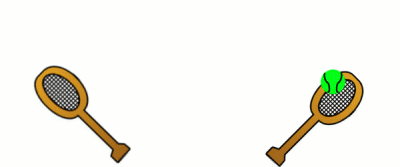
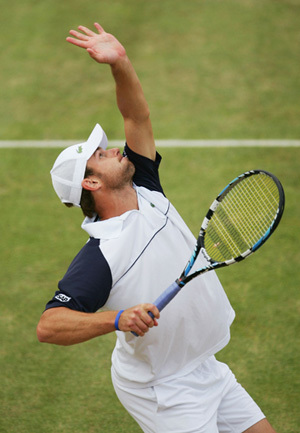
Andy Roddick serving
The rackets used in tennis should only have one pair of crisscrossing strings. Vibration dampening devices are allowed on the rackets, but they can only be placed outside of the strings. No devices that incorporate batteries to help your play are allowed.
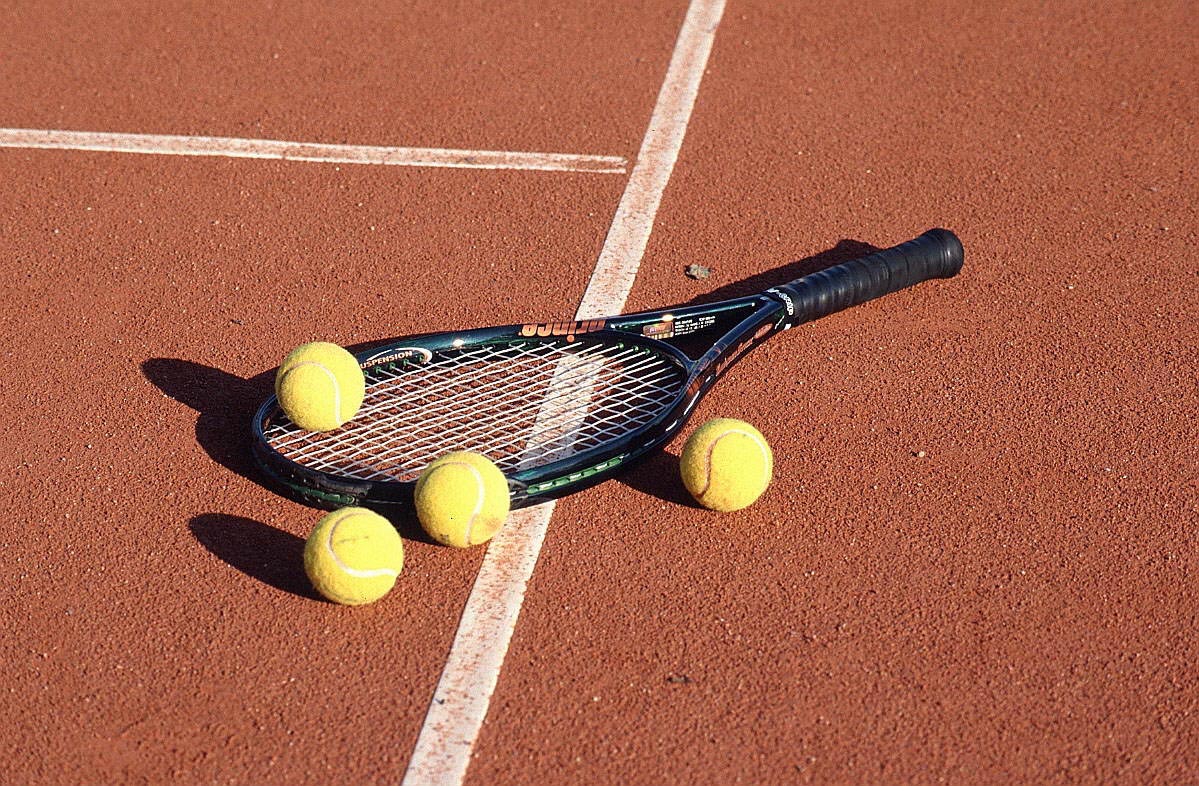
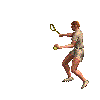
Tennis is a unique game in that it has special names given to the various points awarded. When calling out the score, the person serving the ball should always say their score first. A score of zero is called out by saying ‘Love', and from there, the points go to 15, 30, 40, and game. If both players get a score of 40, the game must become a tie-breaker, and a 40-40 score is announced by saying ‘Deuce'. In a ‘Deuce' situation, if a player gets a point, they are said to have ‘Advantage'. If a player with an ‘Advantage' gets another point, the game is over. If a player gets a point while the other has ‘Advantage', the score is reset to ‘Deuce'. When a game is won, another game is begun until someone gets the best of 7 games. One catch is that they must win by two. If, at the end of 7 games, a player is up 4 to 3, another match must be held as winning by two is necessary. If a player takes the best of 7 games, winning by 2, they are said to have won the match
For more information on the game of tennis you can look at these links:
http://campusrec.arizona.edu/intra/rules/tennisrules.pdf
http://dps.usta.com/usta_master/usta/doc/content/doc_13_16051.pdf?2/9/2007%208:54:17%20PM
If you think you know all the rules and the way of the game take this quiz:
http://tennis.about.com/od/faqandreference/l/aarulesquiz.htm
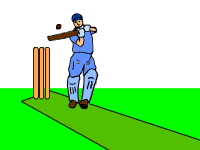
Equipment
- Cricket Ball:
- Hard, cork and string ball, covered with leather. A bit like a baseball (in size and hardness), but the leather covering is thicker and joined in two hemispheres, not in a tennis ball pattern. The seam is thus like an equator, and the stitching is raised slightly. The circumference is between 224 and 229 millimetres (8.81 to 9.00 inches), and the ball weighs between 156 and 163 grams (5.5 to 5.75 ounces). Traditionally the ball is dyed red, with the stitching left white. Nowadays white balls are also used, for visibility in games played at night under artificial lighting.
- Cricket Bat:
- Blade made of willow, flat on one side, humped on the other for strength, attached to a sturdy cane handle. The blade has a maximum width of 108 millimetres (4.25 inches) and the whole bat has a maximum length of 965 millimetres (38 inches).
- Wickets:
- There are two wickets - wooden structures made up of a set of three stumps topped by a pair of bails. These are described below.
- Stumps:
- Three wooden posts, 25 millimetres (1 inch) in diameter and 813 millimetres (32 inches) high. They have have spikes extending from their bottom end and are hammered into the ground in an evenly spaced row, with the outside edges of the outermost stumps 228 millimetres (9 inches) apart. This means they are just close enough together that a cricket ball cannot pass between them.
- Bails:
- Two wooden crosspieces which sit in grooves atop the adjacent
pairs of stumps.
A complete wicket looks like this:
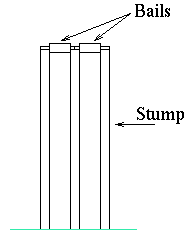
-
- Protective Gear:
-
- Protective Gear:
- Pads, gloves, helmet, etc for batsmen to wear to prevent injury when struck by the ball.
- Shoes:
- Leather, usually with spiked soles for grip on the grass.
- Clothing:
- Long pants, shirt (long or short sleeved depending on the weather), possibly a sleeveless or long-sleeved woollen pullover in cold weather. For games played with a red ball, the clothing must be white or cream. With a white ball, players usually wear uniforms in solid team colours. Add a hat or cap to keep the sun off. There are no regulations regarding identifying marks or numbers on clothing.
The Field
A cricket field
is a roughly elliptical field of flat grass, ranging in size from about
90 to 150 metres (100-160 yards) across, bounded by an obvious fence or
other marker. There is no fixed size or shape for the field, although
large deviations from a low-eccentricity ellipse are discouraged. In
the centre of the field, and usually aligned along the long axis of the
ellipse, is the pitch , a carefully prepared rectangle of closely mown
and rolled grass over hard packed earth. It is marked with white lines.
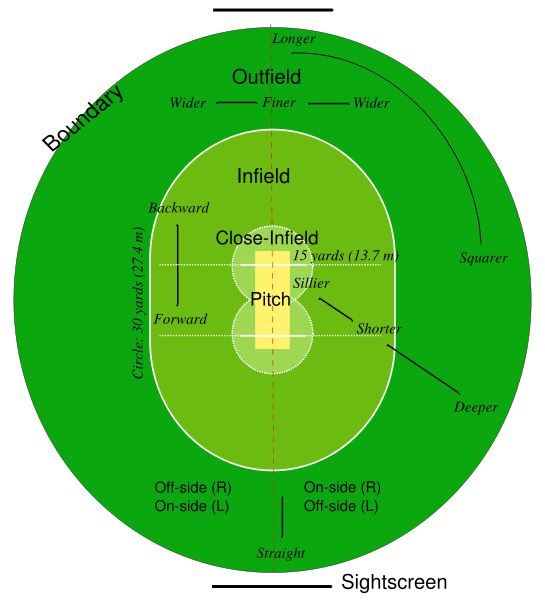
The Play
The order in which the teams bat is determined by a coin toss. The captain of the side winning the toss may elect to bat or field first.
All eleven players of the fielding team go out to field, two players of the batting team go out to bat. The remainder of the batting team wait off the field for their turn to bat. Each batsman wears protective gear and carries a cricket bat.
The game progresses by the bowling of balls. The sequence of events which constitutes a ball follows:
The fielding team disperses around the field, to positions designed to stop runs being scored or to get batsmen out. One fielder is the bo
m the bowler is
the striker, the other is the non-striker. The striker stands before
his wicket, on or near the popping crease, in the batting stance.
The batsman stands with his bat held down in front of the wicket, ready to hit the ball, which will be bowled from the other end of the pitch. The batsman usually rests the lower end of the bat on the pitch and then taps the bat on the pitch a few times as ``warm-up'' backswings.
The non-striker simply stands behind the other popping crease, waiting to run if necessary. The bowler takes a run-up from behind the non-striker's wicket. He passes to one side of the wicket, and when he reaches the non-striker's popping crease he bowls the ball towards the striker, usually bouncing the ball once on the pitch before it reaches the striker. (The bowling action will be described in detail later.)
The striker may then attempt to hit the ball with his bat. If he misses it, the wicket-keeper will catch it and the ball is completed. If he hits it, the two batsmen may score runs (described later). When the runs are completed, the ball is also considered completed. The ball is considered to be in play from the moment the bowler begins his run-up. It remains in play until any of several conditions occur (two common ones were just described), after which it is called dead. The ball is also dead if it lodges in the striker's clothing or equipment. Once the ball is dead, it is returned to the bowler for the next delivery (another name for the bowling of a ball). Between deliveries, the batsmen may leave their creases and confer with each other.
When one bowler has completed six balls, that constitutes an over. A different member of the fielding team is given the ball and bowls the next over - from the opposite end of the pitch. The batsmen do not change ends, so the roles of striker and non-striker swap after each over. Any member of the fielding team may bowl, so long as no bowler delivers two consecutive overs. Once a bowler begins an over, he must complete it, unless injured or suspended during the over.
wler. He takes the ball and stands some distance behind one of the wickets (i.e. away from the pitch). Another fielder is the wicket-keeper, who wears a pair of webbed gloves designed for catching the ball and protective pads covering the shins. He squats behind the opposite wicket. The rest of the fielders have no special equipment - gloves to assist catching the ball are not allowed to anyone but the wicket-keeper.
One batsman stands behind each popping crease, near a wicket. The batsman farthest fro
Another possibility during a ball is that a batsman may get out. There are ten different methods of being out - these will be described in detail later. If a batsman gets out, the ball is dead immediately, so it is impossible to get the other batsman out during the same ball. The out batsman leaves the field, and the next batsman in the team comes in to bat. The not out batsman remains on the field. The order in which batsmen come in to bat in an innings is not fixed. The batting order may be changed by the team captain at any time, and the order does not have to be the same in each innings.
When ten batsmen
are out, no new batsmen remain to come in, and the innings is completed
with one batsman remaining not out. The roles of the teams then swap,
and the team which fielded first gets to bat through an innings. When
both teams have completed the agreed number of innings, the team which
has scored the most runs wins.
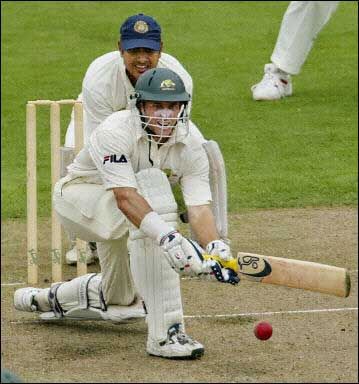
Cricket game
Scoring Runs
Whenever a batsman hits the ball during a delivery, he may score runs. A run is scored by the batsmen running between the popping creases, crossing over midway between them. When they both reach the opposite crease, one run is scored, and they may return for another run immediately. The fielding side attempts to prevent runs being scored by threatening to run out one of the batsmen.
If the batsmen are attempting to take runs, and a fielder gathers the ball and hits a wicket with it, dislodging one or both bails, while no batsman is behind that wicket's popping crease, then the nearest batsman is run out. Specifically, the batsman must have some part of his body or his bat (provided he is holding it) grounded behind (not on) the crease.
The batsmen carry their bats as they run, and turning for another run is accomplished by touching the ground beyond the crease with an outstretched bat. The batsmen do not have to run at any time they think it is unsafe - it is common to hit the ball and elect not to run.
If the batsmen run one or three (or five! rare, but possible), then they have swapped ends and their striker/non-striker roles are reversed for the next ball (unless the ball just completed is the end of an over).
In addition to scoring runs like this, if a batsman hits the ball so that it reaches the boundary fence, he scores four runs, without needing to actually run them. If a batsman hits the ball over the boundary on the full, he scores six runs. If a four or six is scored, the ball is completed and the batsmen cannot be run out. If a spectator encroaches on to the field and touches the ball, it is considered to have reached the boundary. If a fielder gathers the ball, but then steps outside or touches the boundary while still holding the ball, four runs are scored. If a fielder catches the ball on the full and, either during or immediately after the catch, steps outside or touches the boundary, six runs are scored.
The batsmen usually stop taking runs when a fielder is throwing the ball back towards the pitch area. If no fielder near the pitch gathers the ball and it continues into the outfield again, the batsmen may take more runs. Such runs are called overthrows. If the ball reaches the boundary on an overthrow, four runs are scored in addition to the runs taken before the overthrow occurred.
Runs scored by a batsman, including all overthrows, are credited to him by the scorer. The number of runs scored by each batsman is an important statistic.
If, while running multiple runs, a batsman does not touch the ground beyond the popping crease before he returns for the next run, then the umpire at that end will signal one short, and the number of runs scored is reduced by one.
There are many different ways to get out. If you want to learn more
about the great game of cricket you can visit:
http://www.cs.purdue.edu/homes/hosking/cricket/explanation.htm#basics
http://www.allworldknowledge.com/cricket/index.html
Back to Home
Return to Top
The websites used in this page:
http://westlake.k12.oh.us/hilliard/whspe/volleyball/volleyball_rules.htm
http://www.farmington.k12.mn.us/fms/pe/studyguides/thb/thb.htm
http://schools.cbe.ab.ca/b628/Physical%20Education/European%20Handball%20Study%20Sheet.htm
http://ezinearticles.com/?The-Basic-Rules-of-Tennis&id=288575
This page was designed and published by Michael Galeotafiore
and is soley responsible for its contents.
Last updated: May 14, 2008